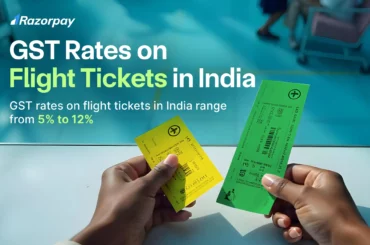SEZs are duty-free zones that are taxed as foreign territories to encourage investment and trade. The implementation of GST and e-way bill rules requires SEZ entities to provide e-way bills for each transfer of goods valued at more than ₹50,000. This measure improves operational transparency and synchronises SEZ transactions with national tax compliance.
SEZ supplies are treated the same way as other interstate supplies. However, there’s an exemption: if a supply is made from an SEZ to a DTA (Domestic Tariff Area), it will be treated as an import and will again be outside the periphery of GST. Individuals and businesses in SEZs can claim ITC on goods and services, enhancing cost-efficiency while adhering to GST compliance requirements.
Table of Contents
What is SEZ in GST?
The SEZ’s full form in GST is Special Economic Zones. Located within a country’s national borders, an SEZ is a dedicated zone where businesses can enjoy simpler tax and easier legal compliance. They are treated as a foreign territory for tax purposes.
This unique setup allows any goods or services supplied to an SEZ developer or unit to be considered a zero-rated supply under the Goods and Services Tax (GST), meaning these supplies attract a zero-tax rate and are exempt from GST.
Suppliers have two main options for supplying goods to SEZs:
- Supply under a Letter of Undertaking (LUT) or bond, which exempts them from paying the IGST and claims an input tax credit (ITC).
- They can opt to pay IGST at the time of supply and later claim a refund for these taxes paid.
If an SEZ supplier decides to supply goods or services to another SEZ supplier, then it is considered a zero-rated supply.
There is an exception where supplies from Special Economic Zones (SEZs) to Domestic Tariff Areas (DTAs) are recognised as exports to the DTA and attract customs duties and other applicable import duties.
Impact on SEZ Under the GST
1. Export Under SEZ in GST
Exporting goods or services from a SEZ involves sending them out of India using any mode of transport, such as air, sea, or road. This transaction encourages trade and investment, giving SEZ businesses a competitive lead in the global market.
Intra-SEZ transactions, where goods or services are supplied from one unit or developer within the SEZ to another in the same SEZ or to a unit in another SEZ, are important in promoting economic activity within these zones.
Under the GST regime, transactions involving the export from SEZs are treated as zero-rated supplies, allowing businesses to claim refunds for SEZs on the input tax credit (ITC). This exemption under GST significantly reduces the cost of operations for units within SEZs, enhancing their competitiveness in global markets.
However, if a SEZ unit exports goods to a DTA, the DTA treats the shipment as an import, and import taxes and customs duties are applied.
2. Import Under SEZ in GST
Importing into a SEZ from outside India using any mode of transport is a major strategic procedure for promoting industrial and economic growth within the SEZ.
Intra-SEZ transactions, which include exchanging products or services between units or developers inside the same or different SEZs, are essential for promoting intra-zone trade and collaborations.
When supplying goods to SEZs, suppliers can choose to pay the IGST beforehand and claim an ITC credit, or they can pay the IGST upfront and receive a refund of the taxes they paid.
Zero-rated supplies make SEZs profitable for suppliers, and particular tax exemptions and favourable treatment also apply to transporting products and services into these zones.
How do GST Rules Apply to SEZ?
1. Zero-Rated Supplies for SEZs:
Under SEZ GST rules, supplies to Special Economic Zones (SEZs) are considered “zero-rated” supplies. This means businesses that supply goods or services to SEZ units do not have to pay GST on these supplies, making it financially beneficial for them.
Zero-rated supplies allow these businesses to claim a refund on the Input Tax Credit (ITC) for taxes paid on inputs used to make these supplies, further reducing their cost of operations and enhancing their competitiveness.
2. Supplying From SEZ to DTA:
When an SEZ unit supplies goods to the domestic tariff area (DTA), the situation is different. These transactions are treated as if the goods are being imported into India from a foreign country.
Therefore, Integrated Goods and Services Tax (IGST) applies to these supplies and must go through customs clearance. This process ensures that the goods are taxed similarly to imports, maintaining a level playing field for domestic producers and SEZ units supplying goods to the domestic market.
The documents required for supply to SEZ under GST include a bill of supply, GST invoice, shipping bill/bill of export, packing list, and endorsement by SEZ for supplies under GST.
E-Way Bill Rules for SEZ
Under the Goods and Services Tax (GST), transporters must carry an e-way bill for moving goods worth more than ₹50,000 from one location to another. This rule is uniform across India, including supplies to and from Special Economic Zones (SEZs).
SEZ supply under GST is treated on par with other inter-state supplies, meaning SEZ units or developers must adhere to the same e-way bill procedures as those outside SEZs. Specifically, when goods are supplied from an SEZ to a Domestic Tariff Area (DTA) or any other place, the registered individual or entity is responsible for generating an e-way bill.
Let’s consider XYZ, an SEZ unit located in Karnataka, planning to supply goods valued at ₹75,000 to recipient A in Bangalore.
Despite the supplier and recipient being in the same state, the transaction is treated as an inter-state supply because it involves an SEZ.
Therefore, XYZ must know how to generate an E-way bill for this transaction, ensuring compliance with GST regulations for the smooth movement of goods from the SEZ to DTA. Additionally, use the GST calculator to verify GST calculations for SEZ transactions.
Tax Benefits and Exemptions in SEZ Transactions
1. Zero-Rated Supply Provisions
Supplies made to or from SEZs are treated as zero-rated under GST, which means GST is not levied. However, businesses can still claim a refund on input taxes paid, even though the final supply is taxed at 0%.
2. Input Tax Credit (ITC) Availability
SEZ businesses can avail of Input Tax Credit (ITC) on goods or services used to make zero-rated supplies. ITC helps reduce their net tax liability by offsetting taxes already paid on inputs.
3. Customs Duty Exemptions
Units operating in SEZs are exempt from customs duties on imported goods. This includes both raw materials and finished goods needed for production or other business activities.
4. GST Exemption on Services
Services provided to SEZ units are exempt from GST, as long as these services are used specifically for authorised operations within the SEZ.
Registration and Compliance Requirements for SEZ Units
1. Separate GST Registration Required
SEZ units must register under GST separately from any Domestic Tariff Area (DTA) operations. This ensures proper tracking of SEZ-specific transactions.
2. Mandatory SEZ Online System Use
All SEZ units must register and comply using the SEZ Online System, which handles applications, permissions, and ongoing procedural requirements.
3. Monthly and Annual GST Return Filing
SEZ businesses are required to file both monthly and annual returns, clearly reporting all inward and outward supplies during the respective periods.
4. Proper Record Maintenance
Maintaining accurate records of all transactions is mandatory. This includes all purchases, sales, and GST filings relevant to SEZ operations.
LUT Applicability for SEZs Under GST
1. Making Zero-Rated Supplies Without IGST
With a valid LUT, SEZ units can export goods or services without paying IGST, while still enjoying zero-rated tax benefits under GST.
2. Hassle-Free LUT Filing Process
The process of filing an LUT is simple and can be done entirely through the GST portal, reducing paperwork and time involved.
3. Better Liquidity for SEZ Businesses
Using an LUT avoids the need to pay IGST upfront, improving cash flow and liquidity for SEZ units involved in export-oriented operations.
Conclusion
A special economic zone under GST offers unique opportunities, and there are several benefits of SEZ under GST for businesses, with streamlined compliance and regulations aimed at fostering economic growth and international trade. The interplay between economic dynamism and regulatory efficiency highlights SEZs’ critical role in promoting sustainable development and a thriving business ecosystem.
Frequently Asked Questions (FAQs):
1. What are the key benefits of operating in an SEZ under GST?
Key benefits of operating in an SEZ under GST include:
- Zero-rated supplies, which exempt supplies to SEZs from GST, making them equivalent to exports, and the ability to claim Input Tax Credit.
- For the export of goods or services, all goods enumerated and defined under Section 2(5) of the GST Act are exempt.
- All services enumerated and defined under Section 2(5) of the GST Act are exempt from the supply of goods or services to an SEZ unit.
2. What types of businesses are eligible to operate in SEZs under GST?
Under GST, various types of businesses across sectors can operate within Special Economic Zones (SEZs). This includes manufacturing, trading, service providers, software developers, IT companies, biotechnology firms, and export-oriented businesses. Eligibility criteria typically revolve around compliance with SEZ regulations.
3. Are there any specific compliance requirements for GST in SEZs?
Specific compliance requirements for GST in SEZs include:
- Generating e-way bills for goods valued over ₹50,000.
- Adhering to the same E-way Bill (EWB) procedures as other industry players.
- Treating SEZ supplies as interstate supplies, subject to IGST.
Compliance with these requirements is essential for seamless operations within SEZs and adherence to GST regulations.
4. Can a business move goods between SEZs without GST implications?
Yes, businesses can move goods between Special Economic Zones (SEZs) without GST implications. Such inter-SEZ transactions are treated as supplies for export, exempt from GST. However, customs duties may apply depending on the nature of the goods and destination.
5. Are there any tax exemptions for supplying to SEZs?
Yes, there are tax exemptions for supplying to SEZs, where suppliers can either supply under bond or LUT without payment of IGST and claim credit of ITC or supply on payment of IGST and claim a refund of taxes paid.
6. What are the options available for claiming Input Tax Credit (ITC) on supplies to SEZs?
Businesses supplying goods or services to Special Economic Zones (SEZs) have two options for claiming Input Tax Credit (ITC). They can either supply under a bond or a Letter of Undertaking (LUT) without payment of IGST and claiming credit of ITC, or by supplying on payment of IGST and claiming a refund of taxes paid.
7. Do I need to pay IGST when making outward supplies from an SEZ?
Yes, outward supplies from a SEZ to the Domestic Tariff Area (DTA) are subject to Integrated Goods and Services Tax (IGST). The SEZ unit must generate e-way bills for goods over ₹50,000. This tax is levied as these supplies are treated as inter-state transactions under GST.
8. What are the customs clearance procedures for goods moving from an SEZ to a DTA?
Used IT assets such as laptops, desktops, monitors, and printers can now be moved from SEZ to DTA without a Licence for Restricted Imports under specific conditions, including usage and age limitations and compliance with regulatory requirements.


